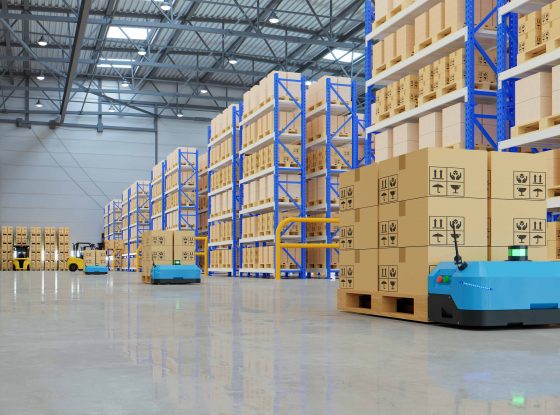Supply chain digital transformation: How and why it matters to your organization?

Digitization has touched upon all aspects of businesses, including supply chains. Technologies such as embedded sensors, GPS, and RFID have helped companies transform their existing traditional (a mix of paper-based and IT-supported processes) supply chain structures into more agile, flexible, open, and collaborative digital models.
Digital transformation in supply chain management enables organizational flexibility, business process automation and accelerates innovation in supply chain management. In order to take maximum advantage of digitized supply chain models, it is important that companies make it an integral part of the overall business model and organizational structure.
In a Mckinsey survey of supply chain executives, 93 percent reported that they are planning to take steps to make their supply chains more resilient, including nearshoring and regionalizing their supply chains.
There’s no denying that organizations are willing to digitize their supply chain management from the traditional approach to improve agility, efficiency, and visibility. On that note, let’s dive into the meaning of digital supply chain management and understand how it is different from a traditional supply chain.
What is a digital supply chain?
In a typical supply chain, the flow of goods and services involves sourcing and procuring raw materials and parts, designing and making a product, estimating the demand, arranging sales channels and logistics, and then providing customers with visibility into their orders.
A digital supply chain, in contrast, provides significantly more visibility into the workings of the chain. It is the process of integrating and applying advanced digital technologies into supply chain operations, from procurement data, inventory management to transportation and distribution. For instance, Bluetooth Low Energy (BLE) asset tracking can provide instant updates on location, including when cargo is in transit.
The ultimate goal of supply chain digitization is to enable insights for greater efficiency and facilitate greater profits. Companies with digital supply chain transformation can better move their resources, people, assets, and inventory to where they are needed at any given time to reduce costs by responding proactively to transportation and manufacturing risks.
The potential payoffs of a fully-realized digital supply chain include saving in every area, including time, resources, money, and reduced environmental footprint.
Traditional vs digital supply chains
Traditional supply chains function on rules based on historical transactional inputs, while supply chains integrated with digital technologies function in real-time. While digital supply chains are networks, traditional supply chains are linear.
In digital supply chain management, information from IT and operational technology systems are integrated, while traditional supply chains often rely on standalone systems. Traditional supply chains require a lot of legwork when it comes to spotting possible problems and predicting likely risks.
With supply chain digitization, in contrast, shared quality and control data can enable companies to anticipate issues and take immediate precautionary measures. Above all, in digital supply chains, machines are driving the decisions with human oversight, while in traditional supply chains, humans are making decisions based on machine inputs.
Why does digital transformation matter in supply chain management?
Digitization in supply chain management empowers your planning, sourcing, and logistics teams to collaborate, automate and effectively leverage analytics. It has also proven to drive growth, mitigate risk, and optimize costs.

Here are a few other supply chain digitization benefits, so let’s dive in!
Organizational flexibility: With a digital operating model, management has greater freedom to choose the appropriate degree of centralization needed to support specialization or minimize process costs given different local labor costs and productivity levels across locations. A major benefit for an organization when it centralizes certain specific functions is higher value through better quality and productivity.
Better decision making: Once your supply chain is integrated with digital technologies, you will make faster and informed decisions for each specific function. Also, you can measure performance accurately and efficiently by aggregating transactions and available information at the macro level, thereby making appropriate decisions to avoid distortions created by average costing.
For instance, BASF, a German multinational chemical corporation, is using AI and machine learning-based technologies to accurately predict when the product stock is running low and what is the optimal time to replenish supply and minimize disruptions. This has led to increased visibility into inventory levels, which supports smarter replenishment planning, more efficient decision making, and, ultimately, better service to customers.
Increases automation: An end-to-end digital platform creates efficiency, improves data accuracy, and increases supply chain efficiency by automating many labor-extensive processes and facilitating decision-making at multiple stages in the lifecycle. Automation also determines the most appropriate shipping mode, carrier, and schedule while considering time, speed, priority, and other elements.
For instance, alerts are generated automatically when purchase orders are in danger of delays or complications. This helps companies to take precautionary measures and be better prepared to handle customers.
Accelerates innovation: All digital transformation processes are aimed towards a single goal – innovation. This improvement over the conventional way of supply chain management will help strengthen the company’s business model and, at the same time, help build relationships with not only suppliers but also customers.
End-to-end customer engagement: Digital transformation in supply chain management will increase customer engagement in his journey. For example, after placing an order, a customer will stay updated with his order details until receiving it with the help of the supplier’s automated tracking system. This will ensure that customers have more control, feel more secure, and appreciate their experience when buying that brand.
Farmer Connect is one such company that uses technologies like Blockchain to connect coffee growers with the consumers they serve. They have launched a mobile application ‘Thank My Farmer’ that allows coffee lovers to trace the quality and origin of their coffee, and even support the farmer who grew the beans. The app connects the user to farmers, traders, roasters, and brands.
Top tech trends in supply chain digital transformation
In this section, you will learn about different supply chain trends you must optimize in 2022 and beyond to improve your organization’s overall productivity and performance. So, let’s begin!

eCommerce integration: Modern-day technology in supply chain management allows B2B sellers to identify and resolve any inefficiencies within their supply chain models.
Connected systems make it possible for them to offer seamless customer experiences and run efficient operations. Thus, companies are starting to utilize the benefits of interconnected supply chains for their eCommerce operations, enabling a free flow of information across departments.
Artificial intelligence: Artificial intelligence (AI) in the supply chain consists of a toolbox of technology options that help companies understand complex content, enhance human performance, and take over routine tasks.
Currently, AI and analytics help supply chain leaders solve long-standing data silos and governance challenges. Its capabilities allow for more integration and visibility across networks of stakeholders that were previously remote or disparate.
Internet of Things (IoT): IoT is a network of physical objects connected to the internet. The IoT already plays a significant role in the supply chain, but it will likely continue to grow in importance with increasingly diverse applications. In just a few years, 50% of companies could be using other advanced technologies to support supply chain operations.
IoT in manufacturing and supply chain can also be used to improve warehouse management, fleet tracking, inventory control, and even technological and mechanical maintenance. It could be even used to create entirely smart warehouses and fleets, increasing the efficiency.
Blockchain: Blockchain has been incredibly beneficial for businesses to minimize supply chain disruption and improve customer service. By 2024, the global spending on blockchain solutions is projected to reach almost 19 billion U.S. dollars. Over the past few years, this technology trend has integrated different business streams such as carriers, shipping lines, and logistic providers into a single platform.

Blockchain also allows logistics business operations to process data by cutting out waste efficiently. The transparency offered by blockchain technology helps identify issues even before they occur.
Supply chain digital twins: It is a virtual representation of the supply chain that consists of hundreds of warehouses, inventory, assets, and logistics positions. Using AI and advanced analytics, the digital twin simulates the supply chain’s performance, including all the complexities that drive risks and vulnerabilities. A digital twin also increases visibility and helps your workforce to take advantage of opportunities, particularly in complex supply chains.
Five steps to a digital supply chain
Moving from a traditional supply chain to a digital supply chain is a complex process, but taking the first step is essential if you want to reap the maximum benefits of digital transformation. Here are the steps that will help you prepare for digital transformation in your supply chains.
1. Define a vision: The first step for implementing digital transformation in the supply chain is to define a clear vision. Make sure that the vision is aligned with your enterprise goals. These goals can be related to your business objectives, such as better and faster decision making, automated operations, and improved supply chain visibility.
- Assess resources and existing systems: Identify what capabilities you’ll need to achieve your transformation goals and determine the gaps. Look for:
- Legacy systems: Ensure that your existing systems use technology that can support your new goals. Is the technology used by you aligned with your business objectives? Identify digital solutions that will help achieve the desired business outcomes.
- Data collection and analysis: Assess the capabilities of existing systems to generate, collect and analyze data. Check if the data can be accessed easily to draw actionable insights.
Workforce skills: Determine if your team has the necessary skills to work with and adapt to the new business model.
2. Unify data and processes: Use a unified platform to gain complete, end-to-end supply chain visibility. Utilize the enhanced transparency for streamlining core functions, including inventory management, warehouse management, demand forecasting, and logistics. The main objective is to increase visibility for every role and process across the extended supply chain.
3. Automate the planning process: With automated planning, you can simplify tasks and derive meaning from large volumes of data. Replace routine or recurring tasks with automated processes. But do not automate processes that involve complex situations or require collaboration between planners.
4. Use data and analytics: Supply chain leaders need access to real-time data to make informed decisions. It also helps them deal effectively with partners, suppliers, and other related functions. Real-time data also helps identify potential disruptions and increases visibility across the supply chain.
Moreover, you can use AI-powered analytical tools to improve planning processes and draw actionable insights. For instance, using analytics, you can help prevent an out-of-stock situation and adjust inventory accordingly.
5. Align people with processes: Even if you shift to a digital supply chain, it would be futile if your team members were not aligned with the new techniques and processes.
This shift should integrate technologies with processes, people, and management. Without such integration, teams may not be able to achieve the desired results in the new business model.
Final thoughts
The quickly changing technological landscape and heightened customer expectations are causing organizations to revisit how they do business. Integrating the supply chain with digital technologies can lead to greater efficiency, flexibility and build resilience.
For businesses re-evaluating their supply chains, now is the best time to start putting their plans into action. Digital transformation in supply chain today is one of the most effective and safest ways to build a resilient business.
If you are facing any challenges in your digital transformation journey, you can partner with a trusted company like Appinventiv to take care of your adoption and migration needs.
We are a trusted brand that offers digital transformation solutions to help you get acquainted with changes through the shortest learnability curve. We have served digital transformation company across the globe, making it easier during your transformation journey.
Source : appinventiv.com



